From Haven to Home: War and its Aftermath
After Adolf Hitler ascended to power in 1933, American Jews undertook various measures to protest the ever-worsening circumstances of German Jews. They initiated a nation-wide boycott of German goods and organized protest marches and rallies in support of beleaguered German Jewry. Although 100,000 Jews were able to enter the United States during the 1930s, millions more were left stranded as attempts to ease America's immigration restrictions largely failed and other potential havens for Jews barred their entry. With the onset of the war in 1939, Hitler put his plan to annihilate European Jewry into action. On August 28, 1942, the contents of a telegram from Gerhardt Riegner were conveyed to Rabbi Stephen S.Wise. Riegner, an official of the World Jewish Congress in Switzerland, outlined the Nazi intention to exterminate Europe's Jews. Wise remained silent, at the request of U.S. officials, pending official confirmation of the report. Some three months later, the State Department verified what has come to be known as the “Riegner Telegram.” By this time, the Nazis had already murdered more than two million of the six million Jews who ultimately perished in the Holocaust.
World War I
Sponsored by the Jewish Relief Campaign, this World War I poster below features a monumental female figure offering the bounty of America — a tray laden with food — to Europe's destitute women and children. The skyline of New York City and the Statue of Liberty are in the background. Between 1914 and 1924, American Jews raised an unprecedented sixty-three million dollars for relief of their suffering European kinfolk.
 |
Share: Jewish Relief Campaign. Brooklyn: Sackett & Wilhelms Corporation, 1917. Color lithograph poster. Prints and Photographs Division |
Responding to the persecution of Jews in Hitler's Germany, American Jewry organized a nation-wide anti-Nazi boycott movement in 1933. Sponsored by the American Jewish Congress and the Jewish Labor Committee, the massive rally pictured below filled New York City's Madison Square Garden on March 15, 1937. Speakers included John L. Lewis, head of the CIO, New York's Mayor Fiorello LaGuardia, and Rabbi Stephen S. Wise, head of the American Jewish Congress.
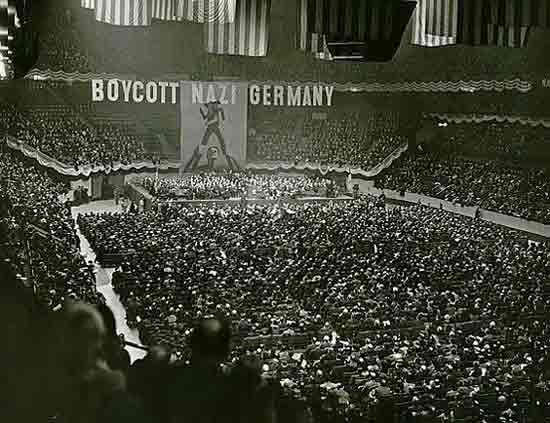 |
Anti-Nazis Hold Demonstration, Madison Square Garden, New York City, March 15, 1937. Gelatin silver print. New York World-Telegram & Sun Newspaper Collection. Prints and Photographs Division |
The dual-sided English-Yiddish broadside displayed below promotes a rally supporting President Franklin Roosevelt and his “policy of all aid to Great Britain, the Soviet Union, and China,” sponsored by the Jewish Peoples Committee, a pro-communist organization. David Dubinsky, president of the International Ladies Garment Union, declined to attend this September 18, 1941, rally because he viewed the sponsoring group as Communist controlled.
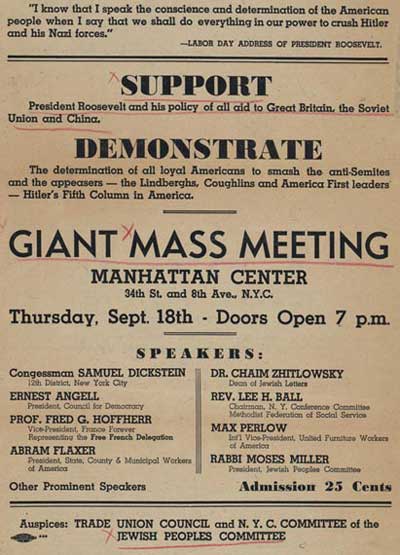 | 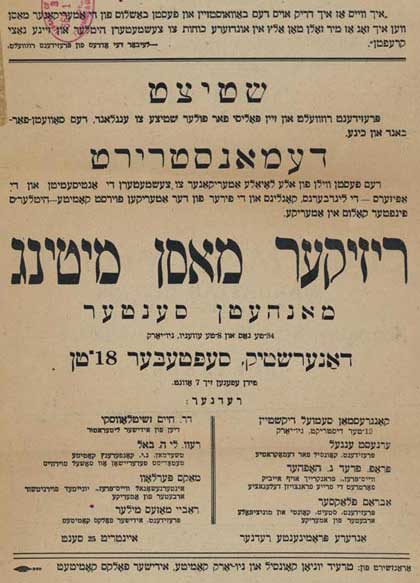 |
Giant Mass Meeting sponsored by the Trade Union Council and New York City Committee of the Jewish People, September 18, 1941. Broadside. Hebraic Section | |
Temple Oheb Sholom in Goldsboro, North Carolina, held a special service to mark V-E Day, May 8, 1945, commemorating the surrender of Nazi Germany the day before. The congregation's rabbi, J. Gershon Tolochko, created a program for a special service, which was then reproduced in scroll form. The service began with the singing of the national anthem, followed by the recitation of a poem of the same name by B. Franklin Hunter. The poem's last stanza read: “And the Star-spangled Banner/ Of peace will yet wave. / O'er the lands cursed with war/ That we still hope to save.”
 |
J. Gershon Tolochko. "Scroll Honoring the United Nations; Special V-Day Services," Temple Oheb Sholom, Goldsboro, North Carolina, [1945]. Hand-colored mimeo type. Hebraic Section |
The hand-drawn plaque below includes dual Hebrew prayers for Winston Churchill and Franklin Roosevelt. The one for Roosevelt, based on the traditional Jewish prayer for the government, reads: “[May He] who gives salvation to President Roosevelt, [He] whose kingdom is everlasting, protect, and increase, and raise up all of the officials of America, and [may] the King of Kings lift them up and lengthen their days in office.”
 |
Hebrew Prayers for Roosevelt and Churchill, ca. 1942. Plaque with hand-drawn flags with manuscript prayers. Hebraic Section |
Less than two months after V-E Day, President Harry S. Truman sent Earl G. Harrison, an expert on immigration and refugees, to investigate charges of mistreatment of Jewish Displaced Persons (DPs) by the U.S. Army. Harrison inspected thirty DP camps and submitted the report below, which changed America's policy towards the Jewish refugees. Displayed here are two pages from the report. The first page shown here outlines Harrison's mission, and the other page, includes Harrison's succinct assessment of the situation: “As matters stand now, we appear to be treating the Jews as the Nazis treated them except we do not exterminate them. They are in concentration camps in large numbers under our military guard instead of the S.S. troops. One is led to wonder whether the German people, seeing this, are not supposing that we are following or at least condoning Nazi policy.”
 | 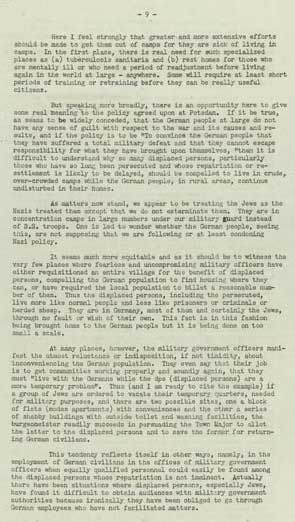 |
Earl G. Harrison (1899-1955). Report, [on a] Mission to Europe to Inquire into the Condition [of] the Displaced Persons. . . . Washington, 1945. National Council of Jewish Women Collection. Manuscript Division | |
President Truman forwarded the Harrison Report to General Dwight Eisenhower, instructing him to take steps immediately to remedy the conditions of the Jewish refugees in the American Zone of Occupation. In his letter to Eisenhower, Truman wrote: “I know that you will agree with me that we have a particular responsibility toward these victims of persecution and tyranny who are in our zone. We must make clear to the German people that we thoroughly abhor the Nazi policies of hatred and persecution. We have no better opportunity to demonstrate this than by the manner in which we ourselves actually treat the survivors in Germany.”
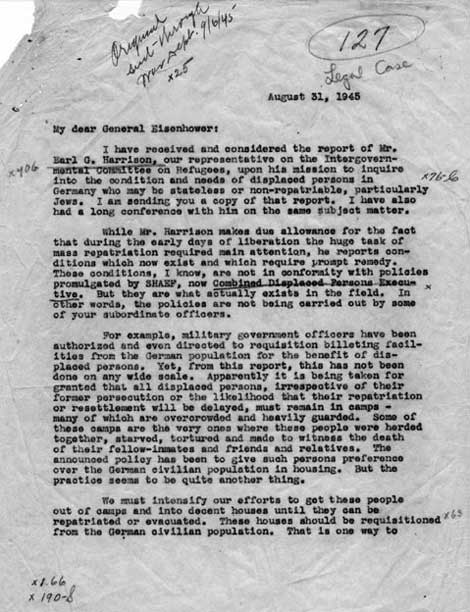 | 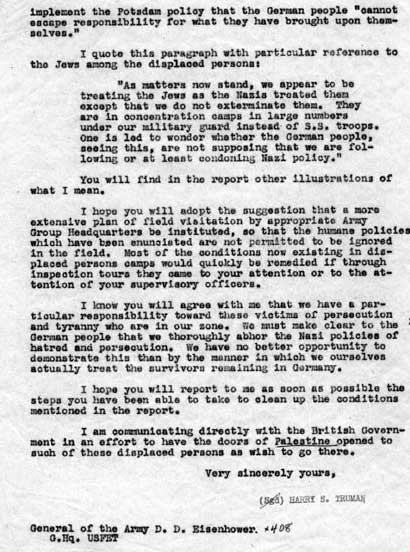 |
President Harry S Truman (1884-1972) to Dwight D. Eisenhower (1890-1969). Typescript letter (enclosed with Harrison Report), August 31, 1945. Courtesy of the Truman Library, National Archives and Records Administration, Independence, Missouri | |
Chaplain Abraham Klausner helped compile an extensive list of Holocaust survivors, which was published by the Central Committee of Liberated Jews in Bavaria under the auspices of the U.S. Army. As noted on the volume's title page below, the list was compiled "so that the lost may be found and the dead brought back to life."
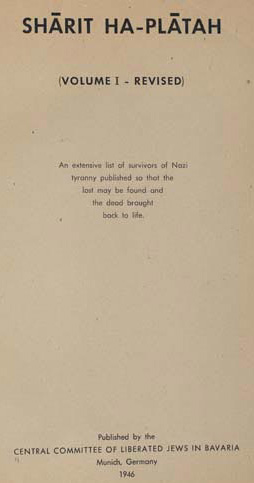 |
She'arit ha-Pley'tah: An Extensive List of Survivors of Nazi Tyranny. . . . Munich: Central Committee of Liberated Jews in Bavaria, 1946. Hebraic Section |
In 1946, under the auspices of the U.S. Army, a special Passover seder was convened in Munich that included many Jewish Holocaust survivors. A special, non-traditional supplement to the haggadah was printed for the occasion, its frontispiece announcing: “We were slaves to Hitler in Germany. . . .” Displayed below is the cover of that haggadah, featuring the insignia of the United States 3rd Army.
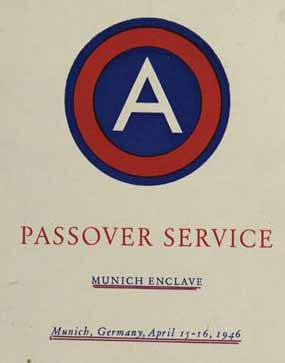 |
Musaf le-Hagadah shel Pesah [Passover Seder Service: Deutsches Theatre Restaurant]. Munich: April 15-16, 1946. Hebraic Section |
At the request of a delegation of rabbis from the Displaced Persons camps, a monumental nineteen-volume edition of the complete Talmud was published in Munich-Heidelberg in 1948 — only three years after the war ended — to help meet the religious needs of Holocaust survivors in the American zone. It is dedicated to the “United States Army,” which provided the opportunity and the means for its publication. Shown below is the title page of this extraordinary work, which connects the Holocaust with the hoped for rebirth of the Jewish people in the Land of Israel. At the bottom of the title page is a depiction of a Nazi slave labor camp flanked by barbed wire; above are the palm trees and the landscape of the Holy Land. The legend reads: “From bondage to freedom; from darkness to a great light.”
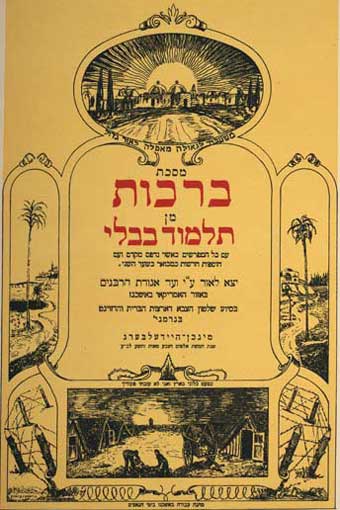 |
Talmud Berakhot [The Survivors Talmud, Vol. 1]. Munich-Heidelberg: United States Army, 1948. Hebraic Section |
Sources: Library of Congress


